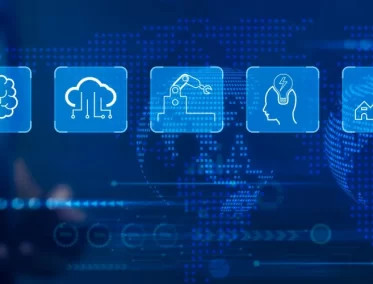As businesses embrace artificial intelligence (AI) to enhance efficiency and decision-making, JD Edwards (JDE) users are exploring ways to integrate AI-driven automation within their on-premises environments. While cloud-based AI solutions are widely available, many enterprises with on-premises JD Edwards EnterpriseOne or JDE World need AI capabilities that align with their infrastructure, security, and compliance requirements.
This blog explores how businesses can leverage JDE AI within on-premises environments, the benefits of AI-powered automation, and best practices for integrating AI-driven tools with JD Edwards ERP systems.
Why JDE AI in On-Premise Setting?
Integrating JDE AI within on-premises deployments enables organizations to harness the power of machine learning, intelligent automation, and predictive analytics while maintaining control over their IT infrastructure. Gartner reports that AI-driven ERP solutions can improve operational efficiency by 40%, reduce manual data entry errors by 60%, and enhance forecasting accuracy by 30%.
- Process Automation – Reduce repetitive tasks and improve workflow efficiency.
- Predictive Maintenance – Use AI to prevent equipment failures and optimize asset management.
- Intelligent Data Processing – Enhance accuracy in finance, supply chain, and inventory management.
- Personalized User Experiences – Improve customer and employee interactions through AI-powered insights.
By implementing AI-driven solutions, JD Edwards users can modernize on-premises operations without moving entirely to the cloud.
JDE AI Key Capabilities
1. AI-Powered Process Automation
JD Edwards Orchestrator plays a pivotal role in AI-driven process automation. Businesses can integrate AI models with JDE Orchestrations to:
- Automate data entry in finance and procurement workflows.
- Trigger AI-driven decision-making for order processing and approvals.
- Use natural language processing (NLP) to process unstructured data, such as invoices or customer emails.
AI-driven bots can extract data from supplier invoices, validate them against purchase orders in JDE, and trigger approvals automatically.
JD Edwards Orchestrator is transforming the way businesses handle complex workflows by integrating AI-driven automation and decision-making. From automating data entry to streamlining approvals, it enables smarter and more efficient operations. Our eBook, A Step-by-Step Guide to Implementing JD Edwards Orchestrator for Maximum ROI, dives into practical strategies, step-by-step implementation tips, and real-world use cases to help you unlock its full potential.
2. AI-Based Predictive Analytics for JDE
Predictive analytics allows businesses to anticipate trends, detect anomalies, and improve forecasting. JDE AI can integrate with on-premises data lakes and business intelligence (BI) platforms to:
- Improve demand forecasting in inventory management.
- Identify supply chain risks and recommend alternative suppliers.
- Analyze customer buying behavior to optimize product offerings.
AI models can analyze historical order data to predict future sales trends, helping businesses adjust inventory levels and reduce overstocking.
3. AI-Driven Predictive Maintenance for JDE Assets
For manufacturing and asset-intensive industries, AI can reduce unplanned downtime and optimize maintenance schedules. IoT sensors integrated with JD Edwards capture real-time equipment data, which AI models analyze to:
- Detect anomalies in machine performance.
- Predict potential failures before they happen.
- Automate work order creation in JD Edwards Enterprise Asset Management (EAM).
A predictive AI model detects unusual vibrations in a manufacturing unit, triggering an automated maintenance request in JDE before a failure occurs.
4. AI-Enhanced Financial Automation in JDE
AI can improve financial operations in JD Edwards by automating:
- Accounts Payable & Receivable Processing – AI-powered OCR (Optical Character Recognition) extracts invoice data and matches it with JDE records.
- Fraud Detection & Compliance – Machine learning algorithms analyze transactions for anomalies and flag suspicious activities.
- Cash Flow Forecasting – AI predicts revenue patterns based on past financial data.
AI-driven cash flow models analyze historical financial transactions to predict potential cash shortages, helping finance teams optimize budgets.
5. AI Chatbots & Virtual Assistants for JD Edwards Users
AI-powered chatbots and virtual assistants can improve user experience and operational efficiency by:
- Automating routine JDE queries (e.g., “What is the status of my purchase order?”).
- Assisting users with data entry tasks and workflow approvals.
- Providing voice-enabled search for JDE reports and transactions.
An AI-powered chatbot integrates with JD Edwards to allow warehouse staff to check inventory levels using voice commands.
How to Integrate AI with JD Edwards
While JD Edwards does not have built-in AI capabilities, businesses can integrate AI models with JDE using:
1. JD Edwards Orchestrator & AI Integration
JD Edwards Orchestrator serves as the bridge between AI models and JDE applications. Businesses can:
- Connect AI-powered analytics tools to JDE via REST APIs.
- Use Orchestrations to trigger AI workflows based on real-time JDE transactions.
- Process large datasets using AI-powered data transformation tools.
A machine learning model integrated with JDE Orchestrator can analyze historical purchase orders and recommend cost-effective suppliers.
2. AI-Enabled Data Pipelines for JDE
To ensure on-premises AI models receive accurate data, businesses should:
- Use ETL (Extract, Transform, Load) tools like Informatica, Talend, or Oracle Data Integrator to process JDE data.
- Implement data lakes to store and analyze large JDE datasets.
- Leverage real-time streaming tools like Kafka for AI-powered insights.
AI-driven supply chain optimization uses real-time order data from JDE, stored in a data lake, to identify delivery bottlenecks.
3. On-Premises AI Model Deployment for JDE
Businesses can deploy AI models in on-premises infrastructure using:
- Oracle Machine Learning for SQL – Integrate AI models directly with Oracle databases.
- Python & TensorFlow APIs – Run machine learning models on local servers while integrating with JD Edwards.
- Docker & Kubernetes – Deploy AI models in on-premises containers for efficient scaling.
An AI fraud detection model runs in a Docker container within an on-premises JDE environment, analyzing financial transactions for anomalies.
Best Practices for Implementing AI in JD Edwards
To successfully integrate JDE AI, businesses should follow these best practices:
- Define Clear AI Use Cases: Identify business-critical areas where AI can drive the most value.
- Ensure Data Quality: AI models require clean, structured data from JDE for accurate predictions.
- Leverage Existing JDE Integrations: Use Orchestrator, APIs, and ETL tools for seamless AI integration.
- Prioritize Security & Compliance: Protect sensitive data by implementing AI governance policies.
- Start with Small AI Pilots: Test AI models on specific JDE workflows before full-scale deployment.
Future of AI in JD Edwards
As AI technologies evolve, JDE AI will continue transforming on-premises JD Edwards environments. Emerging trends include:
- AI-Powered Autonomous ERP – Self-learning systems that optimize JDE workflows in real-time.
- Edge AI for JD Edwards – Running AI models on local IoT devices for real-time processing.
- AI-Driven Predictive HR & Workforce Analytics – Optimizing employee performance & retention strategies.
Rundown!
Integrating AI with JD Edwards enables businesses to automate processes, enhance decision-making, and drive efficiency while maintaining full control over data security & compliance.
By leveraging JD Edwards Orchestrator, AI-powered analytics, and predictive automation, organizations can unlock new opportunities for cost savings, risk management, and intelligent business operations.




